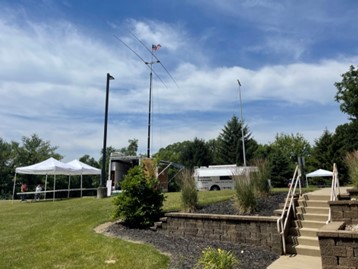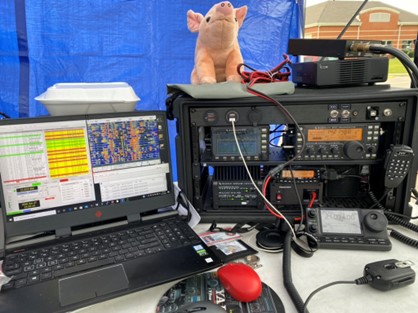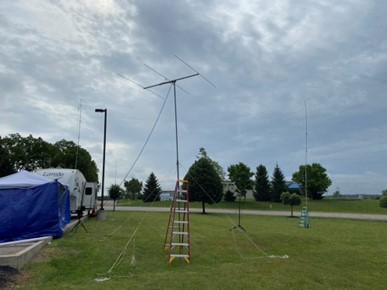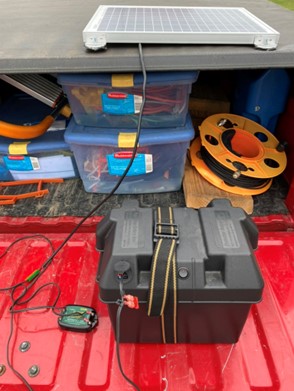
For many amateur radio clubs, Field Day is the biggest event on their calendar. Many hams who don’t participate in contesting or DXing throughout the year find themselves excited to be involved in a successful Field Day operation. It is the thrill of the “non-contest contest,” as the ARRL describes it, that brings out scores of amateurs and new observers to this annual gathering.
The objective of Field Day is to contact as many stations as possible on the 160-, 80-, 40-, 20-, 15- and 10-meter HF bands plus all bands 50 MHz and above. It’s also a great opportunity to learn how to operate in abnormal situations in less than optimal conditions. Here are some basic Field Day rules from the ARRL:
Field Day is open to all amateurs in the areas covered by the ARRL/RAC Field Organizations and countries within IARU Region 2. DX stations residing in other regions may be contacted for credit but are not eligible to be submitted as entries. Each claimed contact must include synchronous information by operators on both sides of the contact. Initiation of a contact can be made either locally or by remote.

Your entry category will need to be reported in each contact. Field Day entries are classified according to the maximum number of simultaneously transmitted signals, followed by a designator indicating the nature of their individual or group participation. The minimum number of transmitters that must be claimed is one. Twenty transmitters maximum are eligible for calculating bonus points (2,000 points maximum). Additional transmitters which may legitimately be used simultaneously will determine your entry category classification but will not earn additional bonus points.
The use of switching systems for lockouts in order to use multiple transmitters (i.e., an “octopus”) in an attempt to enter a lower-number-of-transmitters class is prohibited. An example of this would be using two transmitters that can transmit simultaneously, two operators, and a lockout system and entering class 1A. The use of simulcasting devices which allow a single operator to key and transmit on more than one transmitter at a time is also prohibited. Bonus stations such as GOTA and satellite stations do not count toward the number of transmitters for the class and do not qualify for transmitter bonus points.

Along with number of transmitters is your Class designation. Here is a simplified list from the ARRL:
(Class A) Club/non-club portable: A group of three or more persons set up specifically for Field Day. Such stations must be located in places that are not regular station locations. They cannot use facilities installed for permanent station use or any structure installed permanently for Field Day.
(Class A – Battery) Club/non-club portable: All contacts must be made using an output power of 5 watts or less. The power source must be something other than commercial power mains or a motor-driven generator (e.g., batteries, solar cells, water-driven generator).
(Class B) One or two person portable: A Field Day station set up and operated by no more than two persons. Provisions are the same for Class A except a GOTA or free VHF station are not eligible. One- and two-person Class B entries will be listed separately.
(Class B – Battery) One or two person portable: All contacts must be made using an output power of 5 watts or less and the power source must be something other than commercial mains or a motor-driven generator.
(Class C) Mobile: Stations in vehicles capable of operating while in motion and normally operated in this manner. This includes maritime and aeronautical mobile. If the Class C station is being powered from a car battery or alternator, it qualifies for emergency power but does not qualify for the multiplier of 5, as the alternator/battery system constitutes a motor-driven generating system.
(Class D) Home stations: Stations operating from permanent or licensed station locations using commercial power. Class D may work all Field Day stations.
(Class E) Home stations – Emergency power: Same as Class D but using emergency power for transmitters and receivers. Class E may work all Field Day stations.
(Class F) Emergency Operations Centers (EOC): An amateur radio station at an established EOC activated by a club or non-club group. Class F operation must take place at an established EOC site. Stations may utilize equipment and antennas temporarily or permanently installed at the EOC. Entries will be reported based on the number of transmitters in simultaneous operation.
Get On The Air (GOTA) Station. Any Class A or F entry whose transmitter classification is two or more transmitters may also operate one additional station without changing its base entry category. This is known as the Get On The Air (GOTA) station. The GOTA station may operate on any Field Day band (HF or VHF) but is limited to one GOTA station transmitted signal at any time. The GOTA station must use a different callsign from the primary Field Day station.
Free VHF Station: Any Class A or F entries may also operate one additional transmitter if it operates exclusively on any band or combination of bands above 50 MHz (VHF/UHF) without changing its basic entry classification. This station does not qualify for a 100-point bonus as an additional transmitter. This station may be operated for the club’s Field Day period and all contacts count for QSO credit. It is operated using the primary callsign and exchange of the main Field Day group and is separate and distinct from a GOTA station.

So now you have your transmitter number and Class. The rest of the exchange you share with your contact is your ARRL/RAC section. For example, my section is Ohio or OH. Stations outside the United States or Canada would have a section termed DX. Here are a couple of full exchange examples:
- The group I participate with operates as “3F OH” or “3 Foxtrot Ohio.”
- A club with four transmitters in Mexico would be “4A DX.”

Miscellaneous Rules:
- A person may not contact any station from which they also participate for QSO credit.
- A transmitter/receiver/transceiver used to contact one or more Field Day stations may not subsequently be used under any other callsign to participate in Field Day. Family stations are exempt provided the subsequent callsign used is issued to and used by a different family member.
- Field Day contacts are allowed using Phone, CW and Digital (non-CW) modes. Stations can be worked once per band per mode under this rule.
- NEW for 2023: Each contact must include contemporaneous direct initiation by both operators making a contact. Initiation of a contact can be local or by remote control. Fully automated contacts are prohibited.
- Only one transmitted signal (or data stream) per band is permitted at any time for any of the three event modes. Multi-streaming (e.g., using Fox and Hound Mode, DXpedition Mode, or MSHV) is prohibited.
- All voice contacts are equivalent.
- All non-CW digital contacts are equivalent.
- Cross-band contacts are not permitted. (Satellite QSOs cross-band contacts are exempted).
- The use of more than one transmitter at the same time on a single band-mode is prohibited. A dedicated GOTA station may operate as prescribed in Rule 4.1.
- No repeater contacts are allowed.
- Batteries may be charged while in use. Except for Class D stations, the batteries must be charged from a power source other than commercial power mains. To claim the power multiplier of five, the batteries must be charged from something other than a motor-driven generator or commercial mains.
- All stations for a single entry must be operated under one callsign, except when a dedicated GOTA station is operated as provided under Field Day Rule 4.1.1. it uses a single, separate callsign.
Questions? Share them in the comments below or email me at KE8FMJ@gmail.com.

